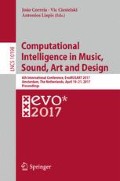Abstract
This paper presents a cyclical system that generates autonomous fitness functions or Agents for evolving short melodies. A grammar is employed to create a corpus of melodies, each of which is composed of a number of segments. A population of Agents are evolved to give numerical judgements on the melodies based on the spacing of these segments. The fitness of an individual Agent is calculated in relation to its clustering of the melodies and how much this clustering correlates with the clustering of the entire Agent population. A preparatory run is used to evolve Agents using 30 melodies of known ‘clustering’. The full run uses these Agents as the initial population in evolving a new best Agent on a separate corpus of melodies of random distance measures. This evolved Agent is then used in combination with the original melody grammar to create a new melody which replaces one of those from the initial random corpus. This results in a complex adaptive system creating new melodies without any human input after initialisation. This paper describes the behaviour of each phase in the system and presents a number of melodies created by the system.
Access this chapter
Tax calculation will be finalised at checkout
Purchases are for personal use only
References
Biles, J.A.: Straight-ahead jazz with GenJam: a quick demonstration. In: MUME 2013 Workshop (2013)
Boden, M.A.: The Creative Mind: Myths and Mechanisms. Psychology Press, New York (2004)
Boden, M.A.: Computer models of creativity. AI Mag. 30(3), 23 (2009)
Brabazon, A., O’Neill, M., McGarraghy, S.: Grammatical evolution. In: Brabazon, A., O’Neill, M., McGarraghy, S. (eds.) Natural Computing Algorithms, pp. 357–373. Springer, Heidelberg (2015)
Bringsjord, S., Bello, P., Ferrucci, D.: Creativity, the turing test, and the (better) lovelace test. In: Moor, J.H. (ed.) The Turing Test, pp. 215–239. Springer, Heidelberg (2003)
Cook, M., Colton, S.: Generating code for expressing simple preferences: moving on from hardcoding and randomness. In: Proceedings of the Sixth International Conference on Computational Creativity June, p. 8 (2015)
Dahlstedt, P.: Autonomous evolution of complete piano pieces and performances. In: Proceedings of Music AL Workshop. Citeseer (2007)
Eigenfeldt, A., Pasquier, P.: Populations of populations: composing with multiple evolutionary algorithms. In: Machado, P., Romero, J., Carballal, A. (eds.) EvoMUSART 2012. LNCS, vol. 7247, pp. 72–83. Springer, Heidelberg (2012). doi:10.1007/978-3-642-29142-5_7
Göksu, H., Pigg, P., Dixit, V.: Music composition using genetic algorithms (GA) and multilayer perceptrons (MLP). In: Wang, L., Chen, K., Ong, Y.S. (eds.) ICNC 2005. LNCS, vol. 3612, pp. 1242–1250. Springer, Heidelberg (2005). doi:10.1007/11539902_158
Hickinbotham, S., Stepney, S.: Augmenting live coding with evolved patterns. In: Johnson, C., Ciesielski, V., Correia, J., Machado, P. (eds.) EvoMUSART 2016. LNCS, vol. 9596, pp. 31–46. Springer, Cham (2016). doi:10.1007/978-3-319-31008-4_3
Jenks, G.F.: The data model concept in statistical mapping. In: International Yearbook of Cartography, vol. 7(1), pp. 186–190 (1967)
Lehman, J., Stanley, K.O.: Efficiently evolving programs through the search for novelty. In: Proceedings of the 12th Annual Conference on Genetic and Evolutionary Computation, pp. 837–844. ACM (2010)
Loughran, R., McDermott, J., O’Neill, M.: Grammatical evolution with zipf’s law based fitness for melodic composition. In: Sound and Music Computing Conference, Maynooth (2015)
Loughran, R., McDermott, J., O’Neill, M.: Tonality driven piano compositions with grammatical evolution. In: 2015 IEEE Congress on Evolutionary Computation (CEC), pp. 2168–2175. IEEE (2015)
Loughran, R., McDermott, J., O’Neill, M.: Grammatical music composition with dissimilarity driven hill climbing. In: Johnson, C., Ciesielski, V., Correia, J., Machado, P. (eds.) EvoMUSART 2016. LNCS, vol. 9596, pp. 110–125. Springer, Cham (2016). doi:10.1007/978-3-319-31008-4_8
Loughran, R., O’Neill, M.: Generative music evaluation: why do we limit to ‘human’?. In: Computer Simulation of Musical Creativity (CSMC), Huddersfield, UK (2016)
Miranda, E.R.: On the evolution of music in a society of self-taught digital creatures. Digit. Creativity 14(1), 29–42 (2003)
Munoz, E., Cadenas, J., Ong, Y.S., Acampora, G.: Memetic music composition. IEEE Trans. Evol. Comput. 20(1), 1–15 (2016)
Pearce, M., Wiggins, G.: Towards a framework for the evaluation of machine compositions. In: Proceedings of the AISB 2001 Symposium on Artificial Intelligence and Creativity in the Arts and Sciences, pp. 22–32. Citeseer (2001)
Scirea, M., Togelius, J., Eklund, P., Risi, S.: MetaCompose: a compositional evolutionary music composer. In: Johnson, C., Ciesielski, V., Correia, J., Machado, P. (eds.) EvoMUSART 2016. LNCS, vol. 9596, pp. 202–217. Springer, Cham (2016). doi:10.1007/978-3-319-31008-4_14
Shao, J., McDermott, J., O’Neill, M., Brabazon, A.: Jive: a generative, interactive, virtual, evolutionary music system. In: Chio, C., et al. (eds.) EvoApplications 2010. LNCS, vol. 6025, pp. 341–350. Springer, Heidelberg (2010). doi:10.1007/978-3-642-12242-2_35
Stanley, K.O., Lehman, J.: Why Greatness Cannot Be Planned: The Myth of the Objective. Springer, Heidelberg (2015)
Thywissen, K.: GeNotator: an environment for exploring the application of evolutionary techniques in computer-assisted composition. Organised Sound 4(02), 127–133 (1999)
Todd, P.M., Werner, G.M.: Frankensteinian methods for evolutionary music. In: Griffith, N., Todd, P.M. (eds.) Musical Networks: Parallel Distributed Perception and Performace, p. 313. MIT Press, Cambridge (1999)
Waschka II, R.: Composing with genetic algorithms: GenDash. In: Miranda, E.R., Biles, J.A. (eds.) Evolutionary Computer Music, pp. 117–136. Springer, Heidelberg (2007)
Acknowledgments
This work is part of the App’Ed (Applications of Evolutionary Design) project funded by Science Foundation Ireland under grant 13/IA/1850. We would like to thank the anonymous reviewers for their suggestions on how to improve the paper.
Author information
Authors and Affiliations
Corresponding author
Editor information
Editors and Affiliations
Rights and permissions
Copyright information
© 2017 Springer International Publishing AG
About this paper
Cite this paper
Loughran, R., O’Neill, M. (2017). Clustering Agents for the Evolution of Autonomous Musical Fitness. In: Correia, J., Ciesielski, V., Liapis, A. (eds) Computational Intelligence in Music, Sound, Art and Design. EvoMUSART 2017. Lecture Notes in Computer Science(), vol 10198. Springer, Cham. https://doi.org/10.1007/978-3-319-55750-2_11
Download citation
DOI: https://doi.org/10.1007/978-3-319-55750-2_11
Published:
Publisher Name: Springer, Cham
Print ISBN: 978-3-319-55749-6
Online ISBN: 978-3-319-55750-2
eBook Packages: Computer ScienceComputer Science (R0)

